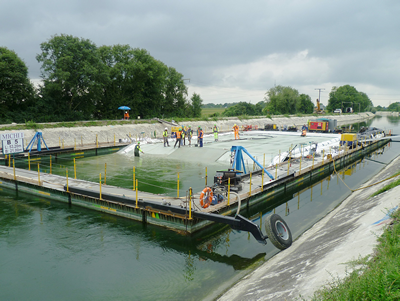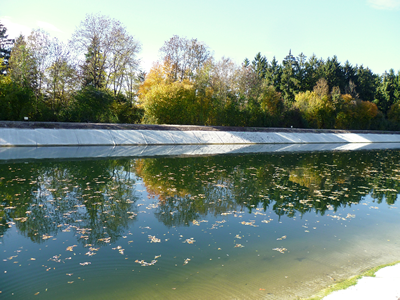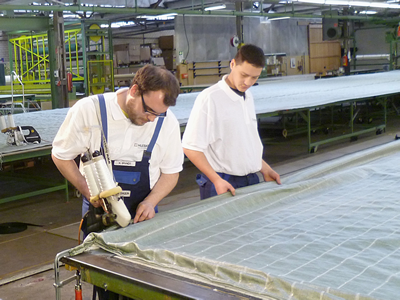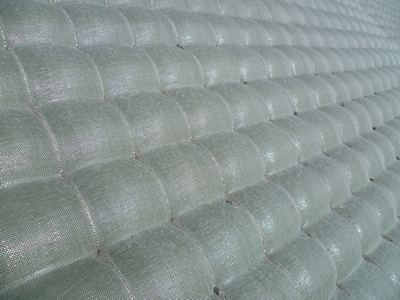
By HUESKER – A project to reinstate the lining along a 3 km section of Germany’s Mittlere-Isar-Kanal (MIK) necessitated the installation of approx. 150,000 m² of Incomat® Standard geosynthetic concrete mattresses within the space of a few months. As the canal is used to generate hydroelectricity, one of the main challenges was to carry out the underwater installation of the mattresses while maintaining at least overnight operation of the power plants.
Located north-east of Munich, the approx. 64 km long Mittlere-Isar-Kanal dates back to the 1920s. With a flow rate of approx. 150 m³/s, the canal is provided with a sequence of seven run-of-river weirs, whose total hydropower output is just short of 130 MW. The resulting annual electricity production of some 580 GWh suffices to supply around 160,000 four-person households.
After almost 90 years of service, the concrete lining exhibited clear signs of ageing. Especially in the intermediate zone between the high and low water marks, the concrete microstructure was heavily damaged. In some places, the cracks and spalling near the construction joints had been exacerbated by the growth of vegetation.
A detailed survey had also revealed large areas of erosion.

Major sections of the canal had already been refurbished between 1997 and 2009 using conventional methods. However, these works had always necessitated drainage of the canal or at least partial lowering of the water level.
For the refurbishment of areas 4a and 5 in 2013, however, any such lowering of the water level was unfeasible due to both operational constraints and water resources regulations. Not only did the works have to be performed completely under water, they also had to accommodate a minimum flow rate of around 18 m³/s.
Moreover, maintenance of the existing water level enabled the hydropower plants on the Mittlere-Isar-Kanal to continue operating during the night-time suspension of works on site (between 8 p.m. and 6 a.m.). As a result, normal energy production during this period prevented an unnecessary loss of earnings for the client and plant operator Eon.
Successful rehabilitation of the various canal sections, with a total length of 3 km, thus depended on the use of a reliable lining system for underwater placement directly onto the existing ageing concrete surface.
Incomat® Standard System

An approx. 150 m test section had already been successfully refurbished in 2009 using HUESKER’s Incomat® Standard geosynthetic concrete mattress. Due to the convincing technical performance and cost-effectiveness of these works, the Incomat® system was subsequently specified in the tender documents for the refurbishment of areas 4a and 5. The contract was awarded to Hagn Umwelttechnik GmbH from Olching, based on proposals for an innovative installation method.
Incomat® Standard comprises two synthetic woven layers connected by an arrangement of spacer tapes. The void between the two layers is filled in-situ with fluid concrete. With the woven layers acting as lost formwork, the system allows the rapid construction of robust concrete revetments, even on steeply sloping surfaces, in both dry and underwater conditions. The variable-length spacers can be used to determine the thickness of the revetment. (No conventional formwork at all is needed.)
Individual Incomat® sheets can be customized to the exact project requirements and factory-preassembled into panels measuring up to around 1,000 m². The high degree of prefabrication and possibility of fabricating large-size, tailored segments bring about a substantial reduction in the amount of work needed on site. The panels can then be stitched or zipped together at the place of installation.
Hoses are used to fill the Incomat® mattresses with fluid, fine-aggregate concrete. The concrete then cures to produce a robust revetment system. Specification of a suitably thick mattress ensures that the concrete fill provides an adequately watertight barrier. The geotextile formwork used to refurbish areas 4a and 5 had an average thickness of around 12 cm and a minimum thickness of 10 cm.
Particular Challenges

One key success factor for the project – apart from the timely manufacture of a large volume of Incomat® Standard mattresses within only a few months – was the flexible, high-quality customization process. This involved the connection of individual sheets, facing of the underside with a protective nonwoven, and the fitting of zips, filler necks plus different-sized straps as an installation or fixing aid.
The pioneering installation method entailed the development of innovative and complex panel details, which demanded the utmost care in design, on-site execution and inspection.
In terms of reliable installation on sloping underwater surfaces, Incomat® Standard is virtually unmatched by any other lining system. The flexible woven formwork was tough enough to withstand the loads imposed by the site operations and adapted itself perfectly to the geometry of the base. Once in place, the lining needed no further protective cover.
The ground-breaking construction procedure not only ensured the daily incorporation of up to 3,000 m² Incomat® mattresses, it also allowed an increase in the night-time flow rate needed for interim operation of the power plants.
The permeability of the installed lining was continuously verified through the extraction of drill cores.
The successful completion of this challenging and intriguing project was not least due to the smooth collaboration between all team members.
www.huesker.de











